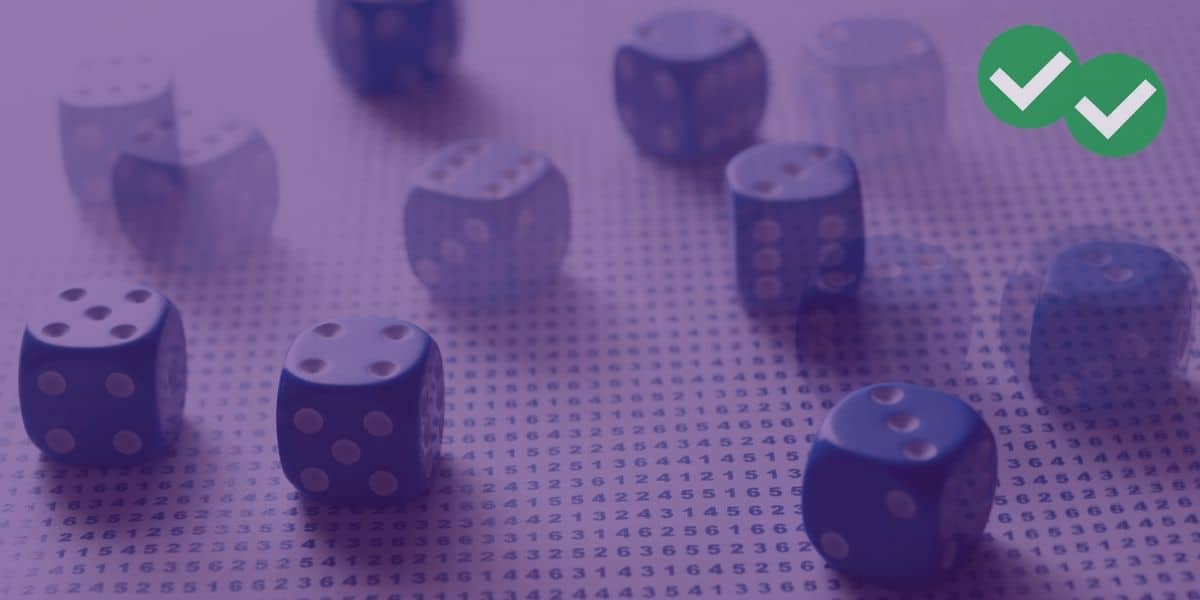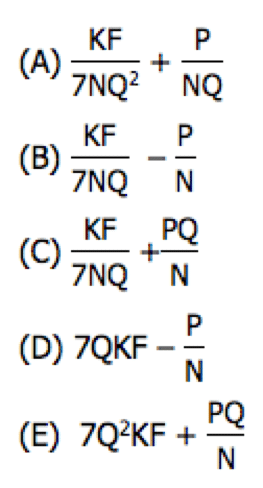This post was updated in 2024 for the new GMAT.
Ready to refresh your memory on GMAT probability rules? In this post, we will focus on probability questions involving the “at least” probability.

The complement rule
There is a very simple and very important rule relating P(A) and P(not A), linking the probability of any event happening with the probability of that same event not happening. For any well-defined event, it’s 100% true that either the event happens or it doesn’t happen.
The GMAT will not ask you probability question about bizarre events in which, for example, you can’t tell whether or not the event happened, or complex events which could, in some sense, both happen and not happen. For any event A in a probability question on the GMAT, the two scenarios “A happens” and “A doesn’t happen” exhaust the possibilities that could take place.
With certainty, we can say: one of those two will occur. In other words:
P(A OR not A) = 1
Having a probability of 1 means guaranteed certainty. Obviously, for a variety of deep logical reasons, the events “A” and “not A” are disjoint and have no overlap. The OR rule, discussed in the last post, implies:
P(A) + P(not A) = 1
Subtract the first term to isolate P(not A).
P(not A) = 1 – P(A)
- That is known in probability as the complement rule, because the probabilistic region in which an event doesn’t occur complements the region in which it does occur.
This is a crucial idea in general, for all GMAT probability questions, and one that will be very important in solving “at least” questions in particular.
The complement of “at least” statements
Suppose event A is a statement involving words “at least”—how would we state what constituted “not A“? In other words, how do we negate an “at least” statement?
Let’s be concrete. Suppose there is some event that involves just two outcomes: success and failure. The event could be, for example, making a basketball free throw, or flipping a coin and getting heads. Now, suppose we have a “contest” involving ten of these events in a row, and we are counting the number of successes in these ten trials.
Let A be the event defined as: A = “there are at least 4 successes in these ten trials.” What outcomes would constitute “not A“? Well, let’s think about it. In ten trials, one could get zero successes, exactly one success, exactly two successes, all the way up to ten successes. There are eleven possible outcomes, the numbers from 0 – 10, for the number of successes one could get in 10 trials.
Consider the following: number of possible successes in ten trials:
0 1 2 3 4 5 6 7 8 9 10
The purple numbers are the members of A, the members of “at least 4 successes” in ten trials. Therefore, the green numbers are the complement space, the region of “not A.” In words, how would we describe the conditions that land you in the green region? We would say: “not A” = “three or fewer success” in ten trials. The negation, the opposite, of “at least four” is “three or fewer.”
Abstracting from this, the negation or opposite of “at least n” is the condition “(n – 1) or fewer.”
- One particularly interesting case of this is n = 1: the negation or opposite of “at least one” is “none.”
That last statement is a hugely important idea, arguably the key to solving most of the “at least” questions you will see on the GMAT.
Solving an “at least” question
The big idea for any “at least” question on the GMAT is:
- It is always easier to figure out the complement probability.
For example, in the above scenario of ten trials of some sort, calculating “at least 4” directly would involve seven different calculations (for the cases from 4 to 10), whereas the calculation of “three or fewer” would involve only four separate calculations (for the cases from 0 to 3).
In the extreme—and extremely common—case of “the probability of at least one”, the direct approach would involve a calculation for almost case, but the complement calculation simply involves calculating the probability for the “none” case, and then subtracting from one.
P(not A) = 1 – P(A)
P(at least one success) = 1 – P(no successes)
This is one of the most powerful time-saving shortcuts on the entire GMAT.
An example calculation
Consider the following simple question.
Two dice are rolled. What is the probability of at least one of the dice rolling a 6?
It turns out, calculating that directly would involve a relatively long calculation — the probability of exactly one 6, on either die, and the rare probability of both coming up 6’s. That calculation easily could take several minutes.
Instead, we will use the shortcut defined above:
P(not A) = 1 – P(A)
P(at least one 6) = 1 – P(no 6’s)
What’s the probability of both dice coming up no 6’s? Well, first, let’s consider one die. The probability of rolling a 6 is 1/6, so the probability of rolling something other than 6 (“not 6”) is 5/6.
P(two rolls, no 6’s) = P(“not 6” on dice #1 AND “not 6” on dice #2)
As we found in the previous post, the word AND means multiply. (Clearly, the outcome of each die is independent of the other). Thus:
P(two rolls, no 6’s) =(5/6)*(5/6) = 25/36
P(at least one 6) = 1 – P(no 6’s) = 1 – 25/36 = 11/36
What could have been a long calculation becomes remarkably straightforward by means of this shortcut. This can be an enormous time-saver on the GMAT!
Practice
Now that you’ve read this post, take shot at these three practice questions before reading the answers and explanations below.
Set #1 = {A, B, C, D, E}
Set #2 = {K, L, M, N, O, P}
- There are these two sets of letters, and you are going to pick exactly one letter from each set. What is the probability of at least one vowel being picked?
- 1/6
- 1/3
- 1/2
- 2/3
- 5/6
Show answer and explanation
P(at least one vowel) = 1 – P(no vowels)
The probability of picking no vowel from the first set is 3/5. The probability of picking no vowel from the second set is 5/6. In order to get no vowels at all, we need no vowels from the first set AND no vowels from the second set. According to the AND rule, we multiply those probabilities.
P(no vowels) = (3/5)*(5/6) = 1/2
P(at least one vowel) = 1 – P(no vowels) = 1 – 1/2 = 1/2
Answer = C
- Suppose you flip a fair coin six times. What is the probability of at least one head in six flips?
- 5/8
- 13/16
- 15/16
- 31/32
- 63/64
Show answer and explanation
P(at least one H) = 1 – P(no H’s)
In one flip, P(“not H”) = P(T) = 1/2. We would need to have this happen six times—that is to say, six independent events joined by AND, which means they are multiplied together.
- In a certain game, you pick a card from a standard deck of 52 cards. If the card is a heart, you win. If the card is not a heart, the person replaces the card to the deck, reshuffles, and draws again. The person keeps repeating that process until he picks a heart, and the point is to measure: how many draws did it take before the person picked a heart and won? What is the probability that one will have at least two “heartless” draws on the first two draws, not picking the first heart until at least the third draw?
- 1/2
- 9/16
- 11/16
- 13/16
- 15/16
Show answer and explanation
A full deck of 52 cards contains 13 cards from each of the four suits. The probability of drawing a heart from a full deck is 1/4. Therefore, the probability of “not heart” is 3/4.
P(at least three draws to win) = 1 – P(win in two or fewer draws)
Furthermore,
P(win in two or fewer draws) = P(win in one draw OR win in two draws)
= P(win in one draw) + P(win in two draws)
Winning in one draw means: I select one card from a full deck, and it turns out to be a heart. Above, we already said: the probability of this is 1/4.
P(win in one draw) = 1/4
Winning in two draws means: my first draw is “not heart”, P = 3/4, AND the second draw is a heart, P = 1/4. Because we replace and re-shuffle, the draws are independent, so the AND means multiply.
P(win in two draws) =(3/4)*(1/4) = 3/16
P(win in two or fewer draws) = P(win in one draw) + P(win in two draws)
= 1/4 + 3/16 = 7/16
P(at least three draws to win) = 1 – P(win in two or fewer draws)
= 1 – 7/16 = 9/16
Answer = B
Bonus Question
The probability is 0.6 that an “unfair” coin will turn up tails on any given toss. If the coin is tossed 3 times, what is the probability that at least one of the tosses will turn up tails?
0.064
0.36
0.64
0.784
0.936
Click here for the answer and video explanation!
If you’re looking to strengthen your Quant skills, Magoosh GMAT can help! We offer over 800 practice questions, 200 video lessons, plus full-length practice tests to help you get your best score. Try us for free with a 1-week trial!






